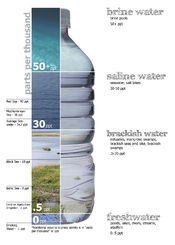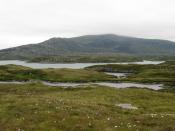Good, Lots of Facts Good facts, Well Presented
The Keys To Unlocking Transitions in Water
When examining waters transition from fresh to salt as well as from salt to
fresh one quickly finds the importance of estuaries. In terms of geology,
present-day estuaries are young and ephemeral coastal features. Today's estuaries
began to take their current form during the last interglacial period, when sea level
rose about 120 m (Braun 36). However, the relatively high sea levels and extensive
estuaries found today have been characteristic of only about 10 to 20 percent of the
last million years. When sea level was lower, during glaciation periods, estuaries
were much smaller than they are at present and were located on what is now the
continental slope. Unless sea level rises, estuaries tend to fill with sediments and
become much smaller. The sediments come from riverborne terrestrial materials
from the eroding continents and from sand transported upstream by the tides from
the continental shelf (Braun 55).
It is in estuaries that most of the world's freshwater runoff encounters the
oceans. Because fresh water is lighter, or less dense, than salt water, unless the
two are mixed by the tides or winds, the fresh water remains at the surface,
resulting in a salinity gradient. Tides force seawater inland as a countercurrent
and produce a saltwater wedge below the freshwater surface waters (Bellamy
62).
Estuaries are always in a state of change and hardly ever in a steady state.
The principal energy source are tides, causing estuarine mixing, but wind, wave
motions, and river runoff can also be important locally (Braun 45). Salt water and
fresh water mix to form brackish water. The three main estuarine
ones--saltwater, brackish, and freshwater--can shift seasonally and vary greatly
from one area to another because of changes in...


